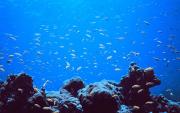Radio Program
Our regular Science and the SeaTM radio program presents marine science topics in an engaging two-minute story format. Our script writers gather ideas for the radio program from the University of Texas Marine Science Institute's researchers and from our very popular college class, Introduction to Oceanography, which we teach to hundreds of non-science majors at The University of Texas at Austin every year. Our radio programs are distributed at to commercial and public radio stations across the country.
In August of 1942, a tropical storm churned to life in the Caribbean Sea. It brought heavy rains to Honduras and Belize, plowed across the Yucatan, then hit the coast near Tampico, Mexico. Finally, it slid into the Rio Grande Valley of Texas, where heavy rains damaged the cotton crops before the storm fizzled.
The numbers of many species of shorebirds are dwindling — the result of loss of habitat, pollution, and other causes. One exception is the Australasian gannet, which inhabits the shores of New Zealand and southern Australia. In Australia alone, thanks to conservation programs and other efforts, its numbers have tripled since 1980.
A mature gannet is about three feet long and has a wingspan of up to five feet. It has a white body with black-tipped wings and a golden head and neck.
Summer is the hottest, driest part of the year for most of the United States. But that’s not the case for parts of the desert southwest. It’s hot all right, but it’s also the wettest time of year. Areas from southern Arizona to western Texas can get half of their annual rainfall in just a couple of months.
The rains are brought by the North American Monsoon — a complex interplay of oceans, land, and air that’s similar to the more famous monsoon in India.
Most anglers have to wait for the fish to come to the bait. But there’s one type of bait that does the work for them: the remora. In some countries, fishermen attach a line to the remora’s tail and toss it in the water. The remora seeks out a big fish, shark, or turtle, latches onto it, and the angler slowly reels them both in.
If you see a sailor or fisherman drop a white disk over the side of the boat, watch it sink for a while, then pull it back up, don’t worry. They haven’t spent too much time in the Sun — they’re doing science.
The open ocean is a bad place for a game of hide-and-seek —there’s no place to actually hide. For the fish that inhabit the open ocean, though, hide-and-seek is no game — it’s a matter of life and death. Many species have developed ways to camouflage themselves to avoid predators. Some change color, for example, while others are like mirrors — they reflect the view around them.
For the islands of Kiribati, the future looks grim. They’re disappearing beneath a rising Pacific Ocean. But the coral reefs around the islands may have a brighter future. A recent study says the reefs could grow as a result of changes in ocean currents.
The horseshoe crab is an engineering marvel. Its hard shell makes it all but invulnerable to predators. It has “eyes” all over its body to sense even the faintest light, as well as wavelengths of light that are invisible to the human eye. Its blood protects it from bacteria — and forms the basis of a compound that protects us as well. And perhaps most amazing of all, it’s one of the oldest forms of life on Earth, barely changed over hundreds of millions of years. Only four species remain, though — one that’s found from Maine to Mexico, and three others in Asia.
Seagrass meadows are some of the most important patches of the ocean floor. They provide habitat for fish, shellfish, and birds. They protect the coast from storms. And recent research found evidence of what may be the most important service of all. They take a lot of carbon out of the atmosphere and store it in the mud below them.
A rainy year generally makes for happy trees. They extend not just up, but out, adding a thick layer of new growth. Scientists can pinpoint such years — as well as dry ones, hot ones, and cold ones — in a tree’s rings. That makes the rings great “time machines” for measuring climate over decades or even centuries.




